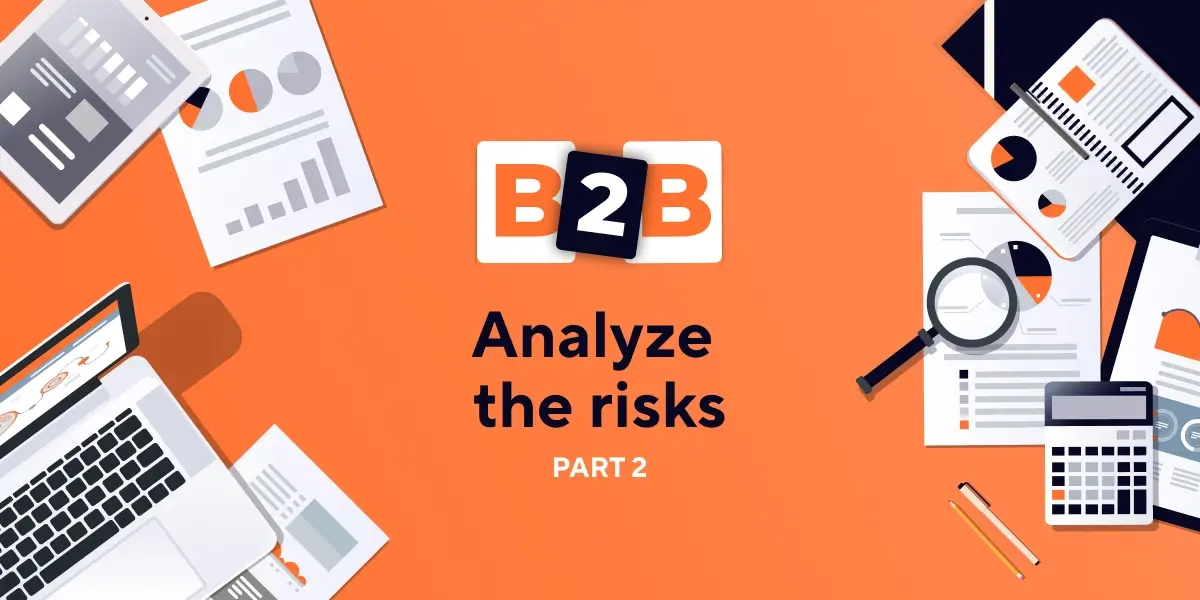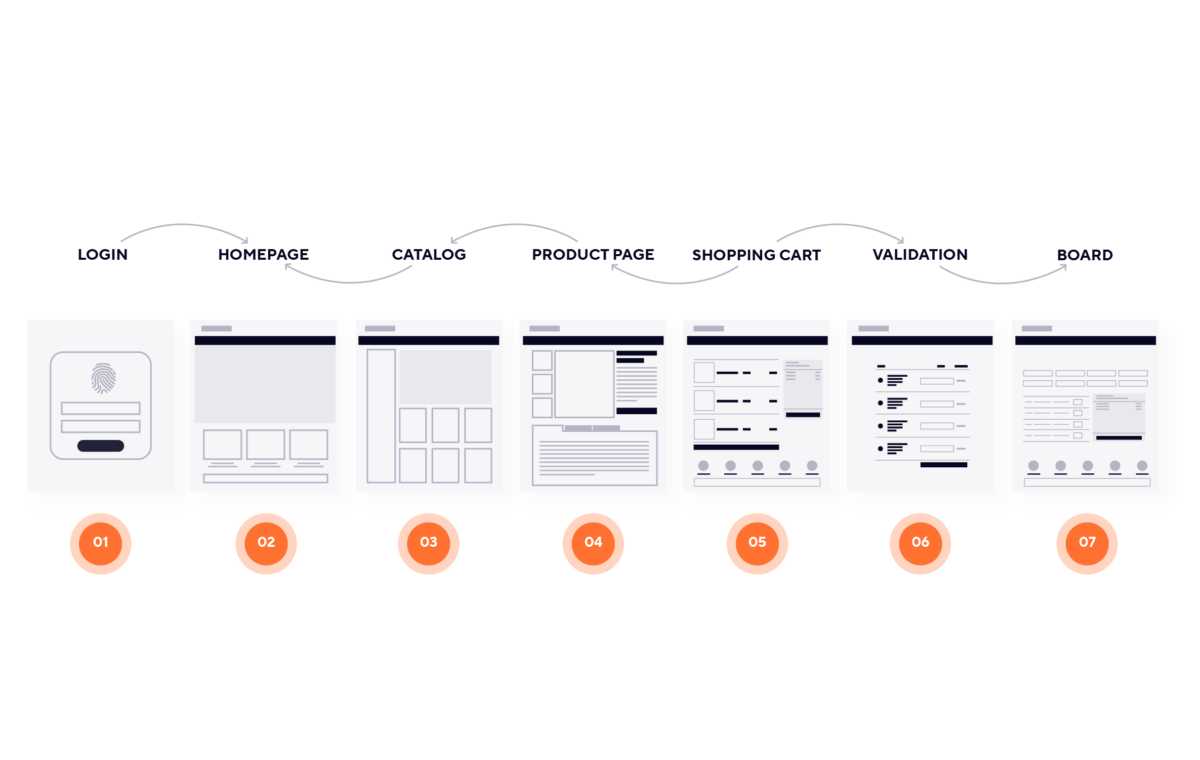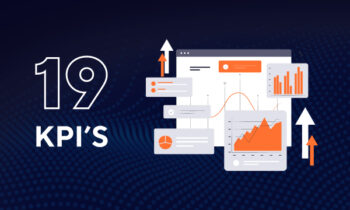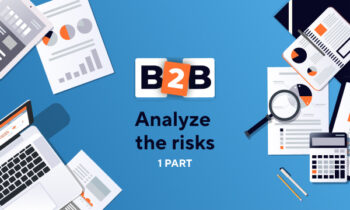Our tips for successfully launching your B2B e-commerce website – Part 2: Risk Analysis

The success of your B2B e-commerce strategy heavily depends on your approach.
In the first article of this series, we discussed the most common pitfalls to avoid when launching a B2B e-commerce project. Since such a project is strategic for your business, it involves the entire organization and requires a real change management process from start to launch, engaging all departments.
To help you create a successful B2B e-commerce platform, we’ve put together a series of articles exploring the challenges, solutions, and specificities of each stage of your platform’s development.
What mistakes should you avoid in your B2B e-commerce project?
Although there may be a sense of urgency, it’s wiser to assess the risks surrounding your B2B e-commerce project before diving headfirst into development. In this second article of our series, we’ll review the most frequent risks you may encounter!
🚨Risk #8: Reinventing the wheel
Deciding to launch an e-commerce project or revamp an underperforming platform often creates a surge of excitement within teams entrusted with the project.
In technical teams, this excitement sometimes leads to the desire to ignore existing tools and start from scratch. While this approach is occasionally justified, it can be risky.
Some developers may go even further by choosing to build everything themselves. Intellectually, it’s appealing. Financially, it may seem like a good idea. After all, why pay for a license or subscription when the team can “build it ourselves” quickly?
Encouraged by the confidence of their teams or providers and tempted by the argument that “it will be cheaper,” decision-makers may blindly delegate architectural choices to their teams.
This can lead to major regrets months later when delays pile up due to a lack of availability or expertise from the team. The scope of the task is often underestimated, and operational tasks take precedence, leaving little time for the new project.
At this point, the project may be stuck in a dead-end. The original deadline will be missed, and the chosen technology may require either significant additional resources or a complete switch to another solution.
To avoid this, architecture decisions should align with the project’s strategic goals, ensuring the planned time-to-market is achievable. Apparent savings from avoiding licenses or subscriptions must be compared to the hidden costs of internal development. Every option should be evaluated using a benefit/risk matrix, focusing on the quickest path to market.
🚨Risk #9: Trying to solve everything with IT
Developing e-commerce in a traditional company disrupts established routines. Everyone must learn new terminology and adapt to new ways of working.
IT teams take on a growing role, becoming key contacts for nearly every department, which brings constant requests to solve various problems through development.
If not managed carefully, decision-makers may witness a problematic dependency on IT: internal teams may rely too heavily on IT solutions to address every issue, flooding the project backlog with unnecessary developments.
IT should not be seen as a solution to all problems. In e-commerce, it’s simply a tool serving a strategic goal. The project manager and leadership team must keep this in mind.
Every issue raised during the project should be evaluated to determine whether:
- It contributes to achieving the project’s original goal.
- It requires an IT development or organizational change instead.
In many cases, internal dysfunctions or process issues are better resolved through organizational adjustments rather than IT developments.
🚨Risk #10: Underestimating the marketing budget
A poorly planned B2B e-commerce project with inadequate budgeting will likely consume more resources than necessary. Like a poorly tuned engine that burns too much fuel, such a project will demand more technology and development investments to reach completion.
As a result, by the time the platform launches, there’s little budget left for audience acquisition (advertising, brand awareness, customer retention). Without sufficient marketing pressure, audience acquisition efforts will fall flat, and the project is bound to fail.
From the very start, audience acquisition resources must be calculated, allocated, and protected. The marketing efforts should begin in parallel with the platform’s development.
The marketing budget must ensure strong visibility from launch and during the months that follow. A comprehensive marketing plan should be established to guarantee the platform’s brand awareness and attract a steady flow of visitors to the site.
🚨Risk #11: Neglecting after-sales service
In B2B, purchases are not impulsive or “one-shot” transactions like in B2C. Long-term relationships built on trust are essential.
A critical factor in building trust is after-sales service. Support, troubleshooting, and assistance are major components of a brand’s image, yet they are often overlooked.
One common mistake in B2B e-commerce projects is focusing solely on new customer acquisition, neglecting existing customers and the pre-sales and post-sales relationship. Many B2C-focused providers inadvertently push B2B clients in this direction.
As a result, after-sales tools are poorly integrated into the platform, causing service quality issues and internal workflow overloads.
To succeed, a B2B e-commerce platform must be approached with a comprehensive strategy that covers the entire customer journey, from pre-sales to after-sales. Workflows should be designed to address every stage of the customer journey, with tools and interfaces capable of seamless interaction.
Customer interactions should be simple and smooth, regardless of where they are in the purchasing process. The e-commerce site should aim to make life easier for the customer—it’s that simple.

🚨 Risk #12: Losing control over service providers
When the decision to launch an e-commerce project is made at the executive level, there’s often a sense of urgency to move quickly. However, businesses can face challenges in finding the right service providers, especially in a tight market like France, where there’s a shortage of skilled providers.
In such cases, companies may be tempted to engage the first available provider without thoroughly vetting them, just to avoid project delays.
While commercial pressures may push companies to prioritize speed over contracts, this is a costly mistake that will often backfire, even before the project is completed. Why? Because it’s crucial to clearly define the roles and responsibilities of your providers from the start. As the saying goes, “It goes without saying, but it’s better to say it…”
Controlling your service providers involves reviewing several key points:
1 – Commercial contracts and terms
Carefully review your provider’s terms and conditions to identify any suspicious or overly restrictive clauses.
Pay close attention to liability limitation clauses, as mistakes on your e-commerce platform can have significant consequences.
- Have your legal advisor review the contract and, if necessary, negotiate better terms.
- Remember: until the contract is signed, everything is negotiable!
2 – Warranty period for delivered services
Did you know that IT services (such as code development) come with a warranty period?
- Make sure your contract includes a warranty, at least three months, to cover any post-delivery issues.
3 – Payment terms
Payments are typically split into installments, such as 30% at order, 30% during development, and the remaining balance upon delivery.
- Negotiate the final payment to be made after the warranty period, giving you leverage if issues arise.
4 – Service Level Agreements (SLAs)
SLAs define response times, incident reporting procedures, and service availability.
Most IT providers include SLAs as part of their terms and conditions or as an annex.
- Carefully review the SLA and request customized terms if needed.
- For example, ensure the SLA covers your specific hosting, maintenance, and incident resolution needs.
5 – Hosting management
Depending on your chosen setup, your B2B e-commerce platform may be hosted internally (on your own servers) or externally (by your provider).
If your provider manages the hosting:
- Ensure the contract includes clear termination terms, allowing sufficient time (e.g., 3 months) for a migration or system switch.
- Verify uptime commitments and penalties for downtime (as detailed in the SLA).
6 – Intellectual property rights and domain ownership
The contract should clearly state what you own and what your provider owns.
Ensure you retain ownership of:
- Your brand assets (logo, domain name, website interface).
- Any custom-developed code, unless the design is based on pre-existing templates provided by the provider.
- Hosting rights, ensuring you can take full control of your platform if needed.
7 – Financial stability
As you are responsible for your subcontractor’s data privacy compliance, you may also be held liable for their social security contributions.
To minimize risk, verify the financial health of any critical provider:
- Request a financial report from a credit insurer or your accountant.
- Ask the provider for their latest financial statements.
🚨 Risk #13: Neglecting legal and fiscal aspects
How many times have I seen lawyers tearing their hair out after discovering an e-commerce platform that forces their clients to undo large parts of the site to ensure legal compliance… and that’s when the intervention doesn’t come directly from the DGCCRF (French consumer protection agency)!
Why does this happen? A lack of awareness of applicable regulations and B2B distribution-specific requirements, leading technical teams to make high-impact decisions beyond their authority.
Selling to professionals via distance selling falls under a specific legal framework.
Adding an online store or expanding its features can change the existing relationships with various stakeholders, especially if you distribute your products through resellers, distributors, or franchisees.
Selling directly or via marketplaces requires compliance with a series of specific regulations, which are becoming stricter each year as part of anti-fraud efforts.
For these reasons, once the scoping workshops are completed, it is essential to submit your master plan and the proposed customer journey to competent legal advisors.
They will ensure, on the one hand, compliance with applicable laws, and on the other hand, that the necessary adjustments are made to your contracts and terms and conditions to reflect this new sales framework.
Developing a B2B e-commerce platform is a long and often challenging process. Being aware of potential risks from the very beginning helps avoid strategic mistakes and ensures that you take all necessary precautions when choosing your partners.


